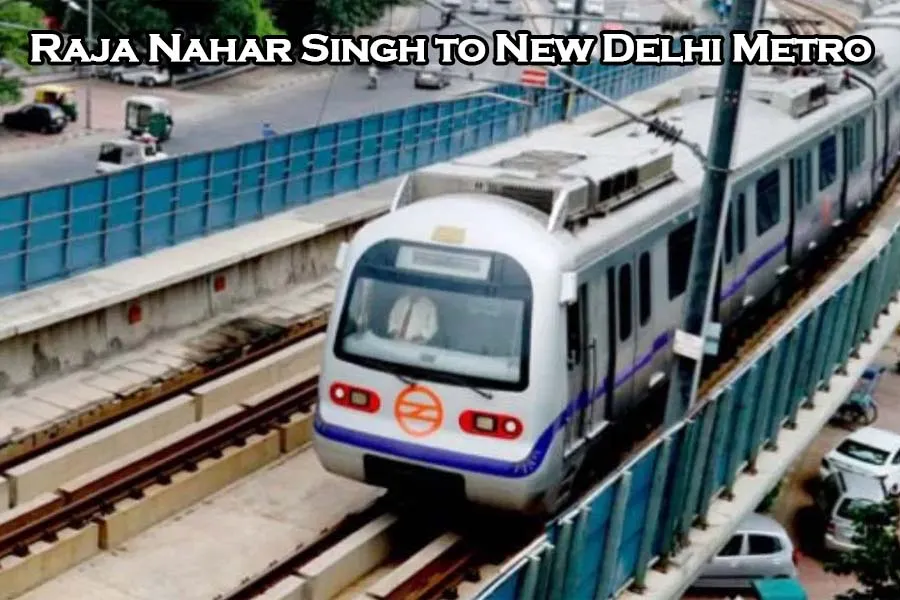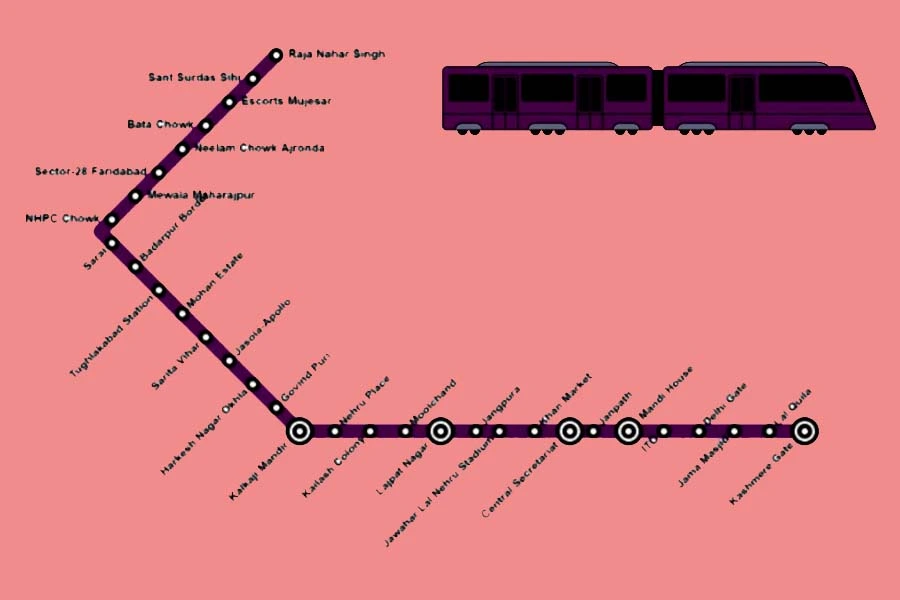Explore the full metro journey from Raja Nahar Singh to New Delhi Metro Station with route map, travel time, and distance covered.

Traveling from Raja Nahar Singh to New Delhi Metro Station is a journey that connects the southernmost tip of the Delhi Metro’s Violet Line to the heart of the capital. Raja Nahar Singh to New Delhi metro route not only serves as a daily lifeline for thousands of commuters from Faridabad and Ballabgarh but also acts as a corridor for students, professionals, and tourists heading to the central business district of Delhi. With its seamless connectivity, modern facilities, and efficient service, the Raja Nahar Singh to New Delhi Metro route is a prime example of the transformation in urban mobility that Delhi Metro has brought to the National Capital Region.
Stations List between Raja Nahar Singh to New Delhi Metro
| Station Name | Line | Distance from Raja Nahar Singh (km) | Fare to New Delhi (INR) |
| Raja Nahar Singh | Violet | 0 | 60 |
| Ballabhgarh | Violet | 1.2 | 60 |
| Sant Surdas (Sihi) | Violet | 2.5 | 60 |
| Escorts Mujesar | Violet | 4.0 | 60 |
| Neelam Chowk Ajronda | Violet | 6.0 | 60 |
| Old Faridabad | Violet | 8.0 | 60 |
| Badkhal Mor | Violet | 10.0 | 60 |
| Sector 28 Faridabad | Violet | 12.0 | 60 |
| Mewala Maharajpur | Violet | 14.0 | 60 |
| NHPC Chowk | Violet | 16.0 | 60 |
| Sarai | Violet | 18.0 | 60 |
| Badarpur Border | Violet | 20.0 | 60 |
| Tughlakabad | Violet | 22.0 | 60 |
| Mohan Estate | Violet | 24.0 | 60 |
| Sarita Vihar | Violet | 26.0 | 60 |
| Jasola | Violet | 28.0 | 60 |
| Okhla | Violet | 30.0 | 60 |
| Govindpuri | Violet | 32.0 | 60 |
| Kalkaji Mandir | Violet | 34.0 | 60 |
| Nehru Place | Violet | 35.0 | 60 |
| Kailash Colony | Violet | 36.0 | 60 |
| Moolchand | Violet | 37.0 | 60 |
| Lajpat Nagar | Violet | 38.0 | 60 |
| Jangpura | Violet | 39.0 | 60 |
| Jawaharlal Nehru Stadium | Violet | 40.0 | 60 |
| Khan Market | Violet | 41.0 | 60 |
| Central Secretariat | Violet(Interchange to Yellow Line) | 43.0 | 60 |
| Janpath | Violet | 44.0 | 60 |
| Mandi House | Violet | 45.0 | 60 |
| ITO | Violet | 46.0 | 60 |
| Delhi Gate | Violet | 47.0 | 60 |
| Jama Masjid | Violet | 48.0 | 60 |
| Lal Quila | Violet | 49.0 | 60 |
| Kashmere Gate | Violet | 50.0 | 60 |
| New Delhi | Yellow/Violet | 51.0 | 60 |

Historical Background
The Raja Nahar Singh Metro Station, formerly known as Ballabgarh Metro Station, is named after Raja Nahar Singh, a prominent Jat king and a hero of the First War of Indian Independence in 1857. The station and the extension of the Violet Line into Ballabgarh were inaugurated in November 2018, marking a significant milestone in the expansion of Delhi Metro’s reach into Haryana.
This extension was flagged off by the Prime Minister, further cementing the importance of the corridor for the region. The New Delhi Metro Station, on the other hand, is one of the oldest and most significant stations in the network, serving as a gateway to the New Delhi Railway Station and the city center. The route between these two stations reflects the city’s growth, its historical roots, and its ongoing journey toward modern, sustainable transportation.
Location and Connectivity
Raja Nahar Singh Metro Station is located in Ballabgarh, Faridabad district, Haryana, at the southern end of the Violet Line. The station serves the rapidly growing urban and suburban areas of Ballabgarh, connecting them directly to Delhi. New Delhi Metro Station is situated in the heart of the capital, adjacent to the New Delhi Railway Station and close to Connaught Place, one of the city’s main commercial and business centers.
The Violet Line itself is a major arterial route, stretching from Raja Nahar Singh in the south to Kashmere Gate in the north, passing through key areas such as Badarpur, Okhla, Lajpat Nagar, and Central Secretariat. The line offers easy interchange with other major lines at stations like Central Secretariat (Yellow Line), Mandi House (Blue Line), and Kashmere Gate (Red and Yellow Lines). This makes the Raja Nahar Singh to New Delhi metro route not just a point-to-point connection but a vital link in the broader Delhi Metro network, facilitating travel across the city and beyond.
Metro Gates and Facilities
Both Raja Nahar Singh and New Delhi Metro Stations are designed with passenger convenience in mind. Raja Nahar Singh station features three main entry and exit gates, each providing access to different parts of Ballabgarh, including the bus stand, railway station, and local markets. The station is equipped with escalators, elevators, and wide staircases to handle large volumes of passengers.
New Delhi Metro Station, being one of the busiest in the network, has multiple gates connecting directly to the railway station, Kamla Market, and other key locations. Facilities at both stations include ticket counters, automated fare collection gates, customer care centers, restrooms, drinking water, ATMs, and waiting areas. The stations are well-lit and monitored by security personnel, ensuring a safe and comfortable environment for all passengers.
| Station | Number of Gates | Key Facilities |
| Raja Nahar Singh | 3 | Escalators, elevators, restrooms, ATMs, parking |
| New Delhi | 5+ | Escalators, elevators, restrooms, ATMs, railway connection |
Public Transport Availability
One of the strengths of the Raja Nahar Singh to New Delhi Metro route is its integration with various modes of public transport. At Raja Nahar Singh station, passengers can easily access local buses, auto-rickshaws, cycle rickshaws, and taxis. The Ballabgarh Bus Stand and Ballabgarh Railway Station are within walking distance, making it convenient for commuters from nearby towns and villages to access the metro.
At New Delhi Metro Station via Raja Nahar Singh to New Delhi Metro the connectivity is even more robust. The station is directly linked to the New Delhi Railway Station, one of the busiest railway hubs in India. DTC buses, auto-rickshaws, and app-based cab services like Ola and Uber are readily available outside the station. This ensures smooth last-mile connectivity for passengers heading to different parts of the city or catching long-distance trains.
Accessibility Features
Delhi Metro places a strong emphasis on accessibility, and both Raja Nahar Singh and New Delhi stations are equipped to cater to passengers with special needs. Ramps, elevators, and escalators are available at all entry and exit points. Tactile flooring guides visually impaired passengers from the entrance to the platforms. Audio announcements and digital display boards provide real-time information about train arrivals and departures.
Accessible restrooms, reserved seating, and wide corridors ensure that the stations are comfortable for wheelchair users, senior citizens, and families with strollers. Staff members are trained to assist passengers who require additional help, making the journey inclusive for everyone.
Navigating Metro Station
Navigating from Raja Nahar Singh to New Delhi Metro Station is straightforward, even for first-time users. At Raja Nahar Singh, passengers can purchase tokens or use their metro smart cards at the ticket counter or vending machine. After passing through security checks and fare gates, they can use escalators or elevators to reach the platform.
Trains on the Violet Line via Raja Nahar Singh to New Delhi Metro are frequent, and digital boards display the expected arrival times. The journey to New Delhi via Raja Nahar Singh to New Delhi Metro involves passing through several key stations, with clear announcements in Hindi and English keeping passengers informed. At New Delhi, follow the signs to your desired exit, whether it’s the railway station, Kamla Market, or the Airport Express Line. Maps and information boards are available throughout the station to assist with navigation.
Nearby Markets and Attractions
The areas around both Raja Nahar Singh and New Delhi Metro Stations offer a wealth of markets and attractions. In Ballabgarh, local markets such as Anaj Mandi, Fruit Mandi, and the main Ballabgarh Market cater to daily needs and traditional shopping. The historic Nahar Singh Palace, now managed by Haryana Tourism, is a popular attraction for visitors interested in history and architecture.
Near New Delhi Metro Station via Raja Nahar Singh to New Delhi Metro the options are even more diverse. Connaught Place, Kamla Market, and Paharganj are all within easy reach, offering everything from high-end shopping to street food and budget accommodations. Cultural landmarks such as Jantar Mantar, Gurudwara Bangla Sahib, and the National Museum are also nearby, making the area a hub for both commerce and tourism.
| Name/Attraction | Distance from Metro | Intent |
| Nahar Singh Palace | 1.5 km | Heritage |
| Anaj Mandi Ballabgarh | 0.8 km | Market |
| Connaught Place | 1.2 km | Shopping/Business |
| Kamla Market | 0.5 km | Shopping |
| Jantar Mantar | 2.0 km | Tourist |
| Gurudwara Bangla Sahib | 2.5 km | Religious |
Nearby Residential and Commercial Properties
The Raja Nahar Singh to New Delhi Metro corridor passes through a mix of residential and commercial zones. In Ballabgarh, neighborhoods such as Chawla Colony, Sector 3, and Shyam Colony offer affordable housing options for families and working professionals. The area is rapidly developing, with new apartment complexes and gated communities emerging.
In central Delhi, the vicinity of New Delhi Metro Station includes residential areas like Paharganj and Karol Bagh, as well as commercial hubs such as Connaught Place and Barakhamba Road. The presence of the metro has boosted real estate values and attracted businesses, hotels, and educational institutions to the area.
| Name/Area | Distance from Metro | Intent |
| Chawla Colony | 0.6 km | Residential |
| Sector 3 Ballabgarh | 1.0 km | Residential |
| Paharganj | 1.0 km | Residential |
| Connaught Place | 1.2 km | Commercial |
| Barakhamba Road | 1.5 km | Commercial |
User Review and Passenger Experience
Passengers using the Raja Nahar Singh to New Delhi Metro route consistently report positive experiences. The journey is praised for its speed, cleanliness, and reliability. Trains are punctual, and the frequency ensures minimal waiting times even during peak hours.
The stations via Raja Nahar Singh to New Delhi Metro are well-maintained, with clean platforms, restrooms, and waiting areas. Security personnel and staff are helpful, providing assistance and information when needed. Digital display boards and clear announcements make navigation easy for new users. Some passengers note that the stations can get crowded during rush hours, but overall, the metro is considered the best way to travel between Ballabhgarh and central Delhi.
Security Features
Security is a top priority on the Raja Nahar Singh to New Delhi Metro route. Both stations are equipped with comprehensive surveillance systems, including CCTV cameras covering all critical areas. Security personnel are stationed at entry and exit points, conducting bag checks and screening passengers. Metal detectors and baggage scanners help maintain a safe environment for everyone.
Emergency response systems, such as panic buttons and help points, are installed throughout the stations. Regular security drills and checks ensure preparedness for any situation. The visible presence of security measures provides peace of mind to passengers, making the metro a safe choice for daily commuting and travel.
Connectivity to Important Locations
The Raja Nahar Singh to New Delhi Metro route offers direct and indirect connectivity to some of Delhi’s most important locations. From Raja Nahar Singh, commuters can reach the industrial and residential areas of Faridabad and Ballabgarh. The line passes through educational hubs like Jamia Millia Islamia, shopping destinations like Lajpat Nagar and Nehru Place, and cultural landmarks such as the Lotus Temple and Humayun’s Tomb.
At New Delhi, the station provides access to the New Delhi Railway Station, Connaught Place, and the Airport Express Line, making it a crucial interchange for travelers heading to the airport or other parts of the city. The Violet Line’s integration with other major lines at Central Secretariat, Mandi House, and Kashmere Gate further enhances its connectivity, allowing passengers to travel seamlessly across the entire Delhi Metro network.
Conclusion
The journey from Raja Nahar Singh to New Delhi Metro Station is more than just a commute; it’s a bridge between the historic and the modern, the suburban and the urban. With its efficient service, comprehensive facilities, and robust connectivity, the route stands as a testament to Delhi Metro’s commitment to transforming urban mobility. Whether you are a daily commuter, a student, a professional, or a tourist, Raja Nahar Singh to New Delhi metro route offers a safe, comfortable, and convenient way to experience the best of Delhi and its neighboring regions. As the city continues to grow, the Raja Nahar Singh to New Delhi Metro corridor will remain a vital artery, connecting people, places, and possibilities.

